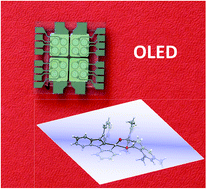Heteroleptic platinum(ii) NHC complexes with a C^C* cyclometalated ligand – synthesis, structure and photophysics†
Abstract
Platinum(II) complexes [(NHC)Pt(L)] with various β-diketonate based auxiliary ligands (L: 3-meacac = 3-methylacetylacetonato, dpm = dipivaloylmethanato, dbm = dibenzoylmethanato, mesacac = dimesitoylmethanato, duratron = bis(2,3,5,6-tetramethylbenzoyl)methanato) and a C^C* cyclometalated N-heterocyclic carbene ligand (NHC: dpbic = 1,3-diphenylbenzo[d]imidazol-2-ylidene, dpnac = 1,3-diphenylnaphtho[2,3-d]imidazol-2-ylidene or bnbic = 1-phenyl-3-benzylbenzo[d]imidazol-2-ylidene) were found to show different aggregation and photophysical properties depending on the auxiliary ligand. Eight complexes were prepared from a silver(I)–NHC intermediate by transmetalation, cyclometalation and subsequent treatment with potassium-tert-butanolate and β-diketone. They were fully characterized by standard techniques including 195Pt NMR. Five complexes were additionally characterized by 2D NMR spectroscopy (COSY, HSQC, HMBC and NOESY). Solid-state structures of five complexes could be obtained and show the tendency of the square-planar compounds to form pairs with different Pt–Pt distances depending on the bulkiness of the substituents at the auxiliary ligand. The result of the photophysical measurements in amorphous PMMA films reveals quantum yields of up to 85% with an emission maximum in the blue region and comparatively short decay lifetimes (3.6 μs). Density functional theory (DFT/TD-DFT) calculations were performed to elucidate the emission process and revealed a predominant 3ILCT/3MLCT character. Organic light-emitting devices (OLEDs) comprising one of the complexes achieved 12.6% EQE, 11.9 lm W−1 luminous efficacy and 25.2 cd A−1 current efficiency with a blue emission maximum at 300 cd m−2. The influence of an additional hole-transporter in the emissive layer was investigated and found to improve the device lifetime by a factor of seven.


 Please wait while we load your content...
Please wait while we load your content...